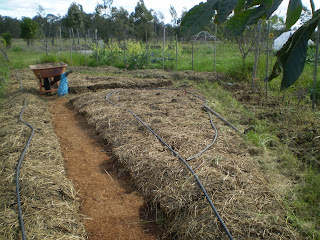 |
| The area is marked out with string lines and roughly hoed to disturb the weeds |
 |
| The weeds are left as organic matter or "green manure" |
 |
| Biscuits of spoiled Lucerne hay are laid tightly to block out light |
 |
| The beds are covered and the paths are left to be mowed by the guinea pigs or covered in sawdust. |
 |
| Irrigation lines are run over the hay biscuits before compost and mineral dust is added and mulch applied. |
 |
| The right side of the garden is planted with zuchinni and the three sisters - corn, beans & squash |
 |
| The left will have Capsicum, egg plant, and pumpkin. |
We have been busy at Purple pear preparing for the summer crops. I have decided to start some "no dig" beds a the sides of the mandalas to utilize the space but as the ground has not had the benifits if the fertility provided by the dome rotation I thought the no dig would add organic matter to the area and boost fertility for the future while producing a crop now.
As you see, we have planted zuchinni and the three sisters on the right of the garden and on the left we are preped for pumpkin, capsicum and eggplant which are all growing on in the plant propagation area, ready for planting.
Excessive rain has come at a great time to soak the hay used to create the beds and the sawdust paths make a better surface to walk on.
We have just a farm tour and a PDC and a weekend workshop on backyard gardening to navigate as well as a couple of workshops for council and the year is over. I will do a couple of days with David Holmgren which will be great. We had the great opportunity to address the Newcastle University last week on sustainable agriculture and CSA (Community Supported Agriculture) and next year we are looking to do more with schools and a community garden is being discussed as well as some workshops with the Housing Department.
Next year may be more crasy than this one and we very much hope to continue the skills for living sustainably workshops but will probably do just one PDC as the interest seems to have wained or money got too tight.




